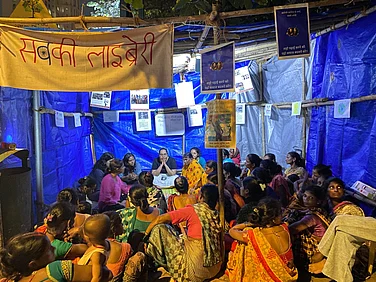Disability or no disability, each one of us especially a student in any stream has a right to access the library. Technically, everyone has a right to access the library indeed. But we cannot deny the fact that we rarely see a person with a disability enjoying reading in the library. I am doing my Ph.D. and being at the library is a major part of my day-to-day life. With a locomotor disability, my last four years of research have not been easy. In all these years, I have never been able to reach or access the book stacks till now; I could never grab a book with my own hands. I use a crutch, walking around the library is a big task let alone getting a book for me on my own. I am often very anxious before entering the libraries. I need assistance for me all the time if I am looking for something specific. My research work requires me to visit different libraries - public and private. I use libraries for research work after finding a call number for a particular book. I need to ask someone in the library to get some books. I am often denied the service or asked to wait or get a friend to do this for me. This process of visiting the library is very disappointing for me as a person with a disability. The inaccessible structures make me realize every day how I could have worked much more efficiently if I would have been an able-bodied person.
The library is an essential part of any educational institution. They are the place for the minds to grow but for a person with a disability, they can be a source of anxiety, resentment, and dejection. My struggle doesn’t end with finding a book; it only starts there. University libraries are often crowded and I find it difficult to navigate to an empty seat that suits my disabled body. The sitting arrangement sometimes doesn't provide enough space for the disabled limbs. A person using a wheelchair finds it difficult to use the sitting area too. The tables have to be of a certain height but most of the time there is not enough space to move the wheelchair around.
The most peculiar problem I have faced is that I can't spend much time in educational institutions' libraries because their disabled washrooms are often stuffed with random things assuming that people with disabilities might never come to the libraries. For a person with sensory impairment, things are differently difficult. While talking to many visually impaired students at Delhi University, I found out that most of them have never used a library. They rely on their personal devices to read and learn. The braille facility is not available at every college. Most of them are located far from their college. A student with visual impairment said that he feels that he is often left behind in the coursework as he waits for the audio versions of books. He often asks his teachers to get him audiobooks.
The educational institutions' libraries are given limited computers equipped with screen reading, enlargement, and synthetic speech programs. Inside the library, it is hard for a person with a disability to navigate. Tactile tiles and large font signs and symbols are a rare sight in libraries. The person with disabilities has to bear all the responsibilities on their shoulders for using the libraries. They need to ask their friends and family to help them out. Most students claim that they avoid going to libraries for the same reasons. My personal experience of visiting the library is also very stressful all the time. I felt that it could have been a lot easier if I knew of a particular seat designed for people with disabilities. A lot of students with disabilities at Delhi University have claimed that if they want to access any online academic journal, they have to be present on campus which is hectic for them. During the lockdown, they were given remote access to the same but as soon as the lockdown was lifted, it was taken back. People with disabilities shared that this made their reading process pretty easier. The rules and regulations are hardly considering people with disabilities.
The sad part is that educational institutions should consider the particular needs of people with disabilities in terms of accessing library resources. If digital education is the future, why not start with the library?
People with both sensory and physical disabilities face problems while accessing libraries. Their issues are diversely pertaining to various disabilities. The huge structure of libraries of educational institutions is not accommodating and is mostly designed to cater to abled bodies. The presence of lifts and ramps cannot be the mark of accessibility. We need an amalgamation of both universal design and accessible design at educational institutions. The Right of Persons with Disabilities Act (RPwD) which was passed in 2016 specifically talks about accessibility to the physical environment, transportation, information, and communications, including appropriate technologies and systems, and other facilities and services provided to the public in urban and rural areas. But it is really hard to comprehend if we are there yet. Every person with a disability can make you count numerous problems while accessing libraries all over the world. The problem starts with the outside of the library. Students claim that the parking should be marked with disabled symbols and they must be closer to the library. The flower vases or dividers which are placed for beautification in the parking area create problems for them to even enter a library.
While entering, people with disabilities use railings. The railings should be there for both ramps and stairs. Sometimes, a person using a crutch finds it difficult to use stairs without the support of railings.
A library could have ambulatory wheelchairs which could be a great help for people who can't walk enough. The awareness campaigns which are also suggested by RPwD Act 2016 can also play a great role in creating an inclusive library. The library staffs are often not trained to understand the needs of people with disabilities; they should have the proper training to help out people with disabilities to use accessible devices. They should have been trained to assist wheelchair and walking aid users. The library websites should also be accessible which is not the case in most Indian libraries. The information should be readily available online, on emails or phones. Many students also find the process of getting a membership to the libraries exhausting. Most Indian libraries still use traditional methods of getting these membership forms cleared and the process is the same for everyone. The processes are not accommodative of students with disabilities.
Educational institutions need to look up to these issues and make them digital which could help both the environment and people with disabilities.The libraries should be designed to be accommodative for students with various disabilities. The process of entering and reading should be disabled-friendly. Libraries are for everyone, they are the source to access knowledge. The impairment and the exclusive inaccessible social and physical environment should not act as a barrier for anyone with a disability.
(Hema Kumari is a Research Scholar at the University of Delhi working around Disability and Gender. She has a locomotor disability as she has Juvenile Rheumatoid Arthritis.)





















